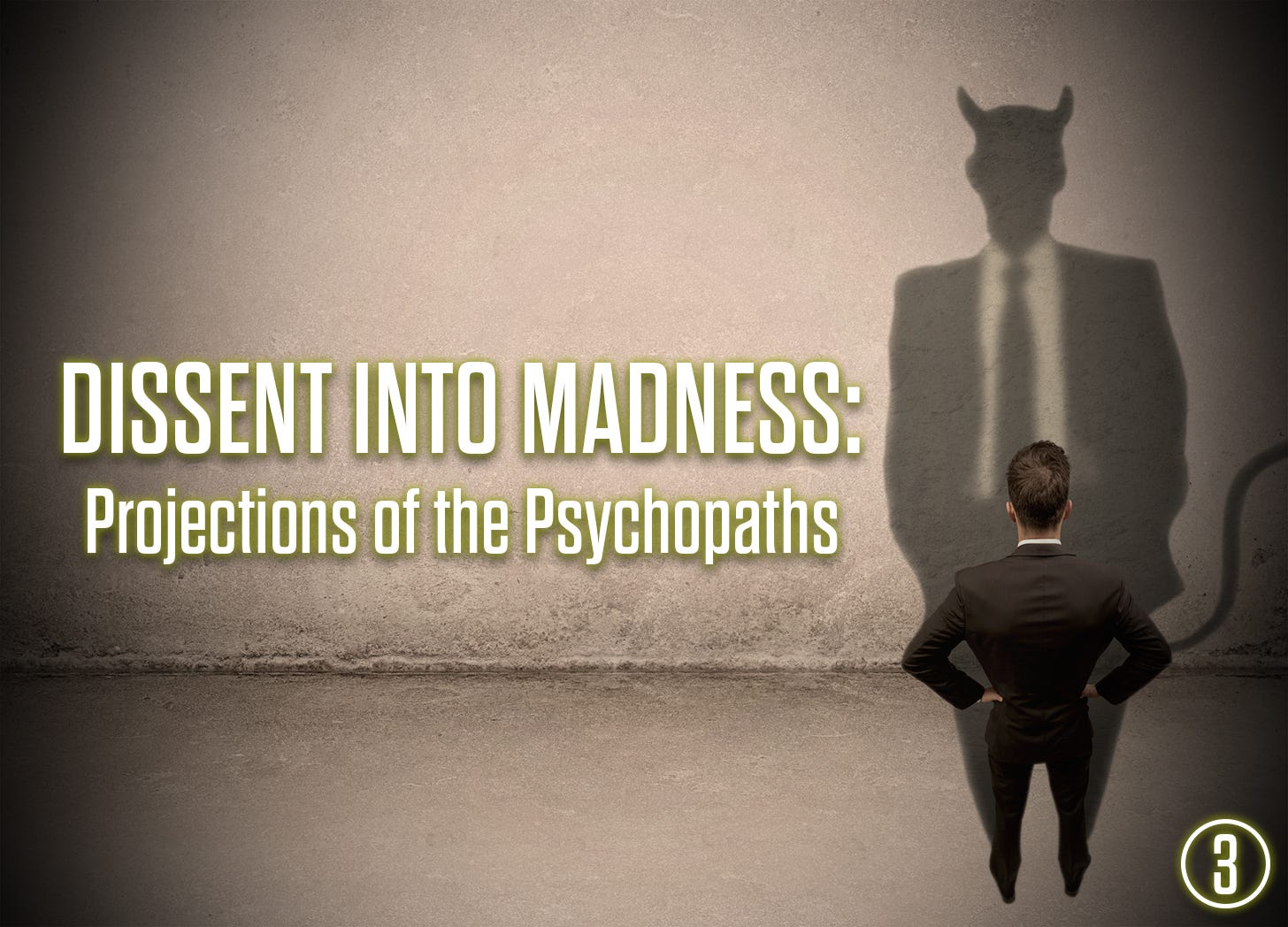Subscribe to Zero-Sum Pfear & Loathing



In Part 1 of this series on Dissent Into Mandess, I recounted the sordid details of “The Weaponization of Psychology,” noting how the psychiatric profession has been turned into an instrument for repressing and marginalizing political dissents.
In Part 2 of this series, “Crazy Conspiracy Theorists,” I detailed how conspiracy theorizing is being pathologized as a mental disorder and how this false diagnosis is being used to justify the forced psychiatric detention and medication of 9/11 truthers and COVID dissenters.
This week, I will examine the great irony of the situation we find ourselves in: that those who are wielding the psychological weapon against any would-be dissenters are themselves driven by a psychopathological disorder . . .

If you are reading this column, chances are you’re already aware of just how insane our society can be.
Maybe you first realized something was deeply wrong with our world when you noticed the discrepancy between what most people actually believe—that JFK was assassinated as the result of a conspiracy, for example—and what you’re expected to say in “polite” society—namely, that the Warren Commission got to the bottom of the matter and that anyone who questions its findings is a crazy conspiracy theorist.
Or perhaps the penny dropped when you heard ex-US Secretary of State Madeleine Albright blithely declare on 60 Minutes that the death of half a million Iraqi children in the State Department’s campaign against Saddam Hussein was “worth it.”
Or maybe you, like many millions of others around the world, began to question the sanity of our society when you saw the madness of the past three years, with governments locking people in their homes and subjecting the poorest among us to starvation and forcing never-before-used medical interventions on billions of people in the name of “public health.”
I, too, have had my own such moments of awareness. And, feeling the frustration that comes from realizing just how sick and twisted the world can be, I am often reminded of Jidda Krishnamurti’s famous observation: “It is no measure of health to be well adjusted to a profoundly sick society.”
But I’ve also found that you get used to the insanity of this sick society after a while. In fact, you come to expect it.
Of course politicians are always lying to the public.
Of course those in positions of power wouldn’t blink twice about killing thousands of their fellow citizens—let alone untold millions in the Middle East—in order to achieve their goals.
Of course they’ll cook up a phoney scamdemic to usher in their biosecurity state and of course it has nothing to do with keeping people healthy.
In fact, once you’ve seen through the lies and realized just how profoundly sick our society has become, it turns out that it’s not the big things that shock you anymore. It’s the little things.
Like the sign above. It’s plastered above the urinal in the washroom at my local cafe and it’s a common enough sign in men’s restrooms here in Japan. It exhorts the reader to take “one step forward” because, even here in Japan, despite Japan’s reputation for obsessive cleanliness, men can sometimes be careless and miss the urinal. That wasn’t what caught my attention, though.
No, what caught my attention about this sign was its invocation of SDGs: GOAL.6. Granted, most people in Japan wouldn’t think twice about this entreaty. But for me it was one of those small yet incredibly sharp reminders of the sickness of our society.
For those not keeping track at home, “SDGs” stands for “Sustainable Development Goals,” the “transformative goals and targets” that the UN unleashed upon the world in 2015 as part of its “2030 Agenda for Sustainable Development.” Goal 6 in particular promises to “Ensure availability and sustainable management of water and sanitation for all,” which is one of those wishy-washy, innocuous-sounding statements that hides a much more nefarious agenda of resource monopolization and population control—tyrannical aims characteristic of so many of the SDGs.
Meanwhile, I have been watching with consternation as the SDGs have begun intruding more and more into everyday life here in Japan. It’s not at all unusual to see a product ad displaying the characteristic coloured boxes indicating which SDG (or SDGs) that product is supposedly promoting (however tenuously), or to see lapel pins sporting the rainbow circle of the SDG logo, now a common accoutrement on the suits of Japanese salarymen.
But to see an SDG here? On a sign over a urinal? Is there truly nowhere we can go where we’re not subjected to this 2030 Agenda for Sustainable Enslavement propaganda and all of the Great Reset/Fourth Industrial Revolution/neo-feudal/transhuman nightmare it invokes?
Perhaps the strangest part of all is that if I were to point out this insanity out to the average person here, they would look at me as if I were the crazy one. And if I were to back up my viewpoint with the volumes of documented information about the perverse nature of this UN-fronted globalist agenda—the information contained in numerous documentaries and podcasts and interviews and articles on the subject—I would doubtless appear even crazier.
“What’s the big deal? It’s just a sign.”
As it turns out, the sign is indeed a sign. A sign that our society is in fact suffering from the effects of a mental illness.

They are “remorseless predators who use charm, intimidation and, if necessary, impulsive and cold-blooded violence to attain their ends.”
They “ruthlessly plow their way through life, leaving a broad trail of broken hearts, shattered expectations, and empty wallets.”
They have “no feelings of guilt or remorse no matter what [they] do, no limiting sense of concern for the well-being of strangers, friends, or even family members.”
Am I talking about politicians? Technocrats? Billionaire “philanthrocapitalists”? Royalty? Captains of industry?
Of course I am. But I’m also talking about psychopaths.
We all know what a psychopath is, or at least we think we do. They’re chainsaw-wielding, crazed serial killers, like Leatherface from The Texas Chainsaw Massacre. Or they’re knife-wielding, crazed serial killers, like Buffalo Bill from The Silence of the Lambs. Or they’re acid-spraying-lapel-flower-wearing, crazed serial killers, like The Joker from Batman.
But if that is what we think of when we think of a psychopath, we find that once again we are the Hollywood predictive programmers’ victims, constructing our understanding of reality not from actual, lived experience but from fictional characters dreamt up by writers and projected on a screen.
In the real world, psychopaths are a subset of the population who lack a conscience. The full implications of this strange mental condition are not apparent to the vast majority of us who do possess a conscience and who assume that the inner life of most people is largely similar to our own.
In The Sociopath Next Door, Dr. Martha Stout, a clinical psychologist who has devoted much of her career to the subject, demonstrates what the absence of a conscience really means by inviting her readers to participate in this exercise:
Imagine—if you can—not having a conscience, none at all, no feelings of guilt or remorse no matter what you do, no limiting sense of concern for the well-being of strangers, friends, or even family members. Imagine no struggles with shame, not a single one in your whole life, no matter what kind of selfish, lazy, harmful, or immoral action you had taken. And pretend that the concept of responsibility is unknown to you, except as a burden others seem to accept without question, like gullible fools. Now add to this strange fantasy the ability to conceal from other people that your psychological makeup is radically different from theirs. Since everyone simply assumes that conscience is universal among human beings, hiding the fact that you are conscience-free is nearly effortless. You are not held back from any of your desires by guilt or shame, and you are never confronted by others for your cold-bloodedness. The ice water in your veins is so bizarre, so completely outside of their personal experience, that they seldom even guess at your condition.
The possibilities for manipulation, deceit, violence and destruction that this condition presents should be obvious by this point. And indeed, as a number of books by psychologists and researchers studying psychopathy—from Howard Cleckley’s seminal 1941 work, The Mask of Sanity, to Robert Hare’s popular book, Without Conscience, to Andrew Lobaczewski’s rescued-from-the-dustbin-of-history-by-an-independent-publisher opus, Political Ponerology—have repeatedly tried to warn the public over the years, psychopaths do exist, they represent something like 4% of the population, and they are responsible for much of the havoc in our society.
So how do we know who is a psychopath? That, as you might imagine, is a highly contested question. While various biomedical explanations for the condition have been proffered—dysfunction of the amygdala and ventromedial prefrontal cortex, for example—and dozens of studies to determine the relationship between brain physiology and psychopathy have been conducted in the past half century, psychopathy is most commonly diagnosed by way of the Psychopathy Checklist, Revised, known as the PCL-R.
Devised by Robert Hare—the most influential psychopathy researcher of the past half-century—the PCL-R involves, among other things, a semi-structured interview in which a subject is tested for 20 personality traits and recorded behaviours, from “egocentricity/grandiose sense of self-worth” to “pathological lying and deception” to “lack of remorse or guilt” to “early behaviour problems.”
Although none of these personality traits are indicative of psychopathy by themselves, the presence of a certain number of them (corresponding to a score of 30 or higher on the PCL-R test) is used to diagnose the condition.
So, how would your average politician score on this test? Let’s see.
Egocentricity / grandiose sense of self-worth?
Pathological lying and deception?
Conning / lack of sincerity?
Lack of remorse or guilt?
Callous / lack of empathy?
Parasitic lifestyle?
Isn’t that the definition of a career politician?
Early behaviour problems?
Check. (<-Actually, this one is straight from Stout’s book . . . but her story of the young boy who uses his “Star-Spangled Banner” firecrackers in their skull-and-crossbones-emblazoned box to blow up frogs is just a “composite” case that isn’t meant to represent anyone in particular, of course.)
I could go on, but you get the idea.
To be fair, a cherry-picked list of isolated examples of politicians’ behaviour like this is not enough to diagnose anyone as a psychopath and, by itself, should not convince you of anything. Nor should you be convinced by the psychologists who have offered their professional opinion on politicians they have not themselves examined—like neuropsychologist Paul Broks, who, in 2003, speculated as to whether Tony Blair was “A Plausible Psychopath?,” or professor of psychology David T. Lykken, who, in the Handbook of Psychopathy, argues not just that Stalin and Hitler were high-functioning psychopaths but that Lyndon B. Johnson “exemplified this syndrome.”
So, is it fair to suspect that psychopaths are overrepresented in the political class? According to Martha Stout, it is:
Yes, politicians are more likely than people in the general population to be sociopaths. I think you would find no expert in the field of sociopathy/psychopathy/antisocial personality disorder who would dispute this. . . . That a small minority of human beings literally have no conscience was and is a bitter pill for our society to swallow—but it does explain a great many things, shamelessly deceitful political behavior being one.
For whatever it’s worth, certain members of the UK government seem to agree. In 1982, one UK Home Office official suggested “recruiting psychopaths to help restore order in the event England is hit by a devastating nuclear attack.” And the reasoning behind this official’s surprising suggestion? The fact that psychopaths “have no feelings for others, nor moral code, and tend to be very intelligent and logical” means they would be “very good in crises.”
To be sure, the a priori case for the utility of psychopathic traits in political office is fairly obvious, but empirical data to back up this intuition is hard to come by. After all, politicians, corporate chieftains, royals and bankers are not administered a PCL-R test before assuming their office or position.
Nonetheless, a number of researchers have offered some data that supports the political and corporate psychopathy thesis. They include:
Even Robert Hare—who has coauthored one of the few empirical studies confirming a higher prevalence of psychopathic traits among corporate professionals in management training programs than in the general population—has said that he regrets spending most of his career studying psychopaths in prison rather than psychopaths in positions of political and economic power. When questioned about this regret, he noted that “serial killers ruin families” while “corporate and political and religious psychopaths ruin economies. They ruin societies.”
The fact that the key positions of political, financial and corporate power in our society are dominated by psychopaths certainly helps to explain why our society is as profoundly sick as we non-psychopaths know it to be. For those who still believe that our sick society can be cured by recourse to the political process, this seems like the worst news imaginable.
. . . But it’s even worse than that. These political psychopaths don’t just ruin societies. They reshape societies in their own image.

In psychology, “projection” refers to the act of displacing one’s own feelings onto another person. As Psychology Today explains:
The term is most commonly used to describe defensive projection—attributing one’s own unacceptable urges to another. For example, if someone continuously bullies and ridicules a peer about his insecurities, the bully might be projecting his own struggle with self-esteem onto the other person.
This concept of projection equips us to better understand why political psychopaths pathologize conspiracy theorists and political dissenters: they are projecting their own mental disorders onto their ideological opponents.
But there is another sense in which psychopaths are “projecting” their pathology onto the world stage. You see, psychopaths do not merely take advantage of their lack of conscience to obtain political or economic power. They use that power to shape the organization they’re leading into a projection of their own psychopathic tendencies.
In one memorable scene from the 2003 documentary, The Corporation, Robert Hare points out that a corporation under the management of a psychopath could itself be diagnosed as psychopathic. Thus, the egocentric and narcissistic tendencies of the psychopath boss are reflected in the development of the corporation’s public relations. The psychopath’s capacity for guilt-free deception and manipulation of others is reflected in the company’s advertising and marketing material. The psychopath’s willingness to commit crimes without shame in pursuit of its objectives finds its analogue in the corporation’s willingness to flagrantly break the law. And the psychopath’s utter lack of remorse for his crimes is mirrored by the corporation’s cynical calculation that fines and punishments for its illegal acts are merely the “cost of doing business.”
But the psychopath does not stop at turning an organization into a projection of his own perverted personality. Be it a business, a bank, or, in the case of a political psychopath, an entire nation, the organization under his control eventually starts to change the character and behaviour of the employees or citizens under its thumb.
The idea that psychopathic systems can make non-psychopaths act like psychopaths might, at first glance, go against our moral intuitions. Surely, we reason, people are either “good people” or “bad people.” They are either psychopathic or sane. They are either the type of person who commits a terrible crime or they aren’t.
As it turns out, however, our reasoning has been proven wrong by research into “secondary psychopathy.” This category of psychopathy, sometimes referred to as sociopathy, is meant to differentiate primary psychopaths—those born with the “lack of conscience” and its associated neurocognitive impairments discussed by Hare, Stout and others—from secondary psychopaths, who develop psychopathic traits as a result of the environment they are functioning in.
There has been many experiments over the decades researching the phenomenon of secondary psychopathy and how “good people” can be placed in situations wherein they will do “bad things,” from the seemingly mundane Asch conformity experiment, which showed that people are often willing to state and even believe demonstrable lies in order to avoid breaking a group consensus, to the truly shocking Milgram experiment, which famously demonstrated that ordinary people could be induced to deliver what they believed to be potentially fatal shocks to strangers on the say-so of an authority figure.
But perhaps the most revealing experiment for the purposes of understanding secondary psychopathy is the Stanford Prison Experiment.
Led by Stanford psychology professor Philip Zimbardo, this 1971 experiment involved recruiting participants from the local community with an offer of $15 per day to participate in a “psychological study of prison life.” The recruits were then screened to eliminate anyone with psychological abnormalities and the remaining candidates were randomly assigned as either guards or prisoners and told to prepare for two weeks of life in the basement of Stanford’s psychology building, which has been converted into a makeshift prison.
The results of that experiment are, by now, infamous. Immersing the participants in the role play with realistic surprise “arrests” of the prisoners by real Palo Alto police officers, the exercise quickly descended into a study in cruelty, with the prison “guards” finding more and more sadistic ways to assert their authority over the “prisoners” and two of the students being “released” from the prison due to the mental distress they were suffering. The experiment was called off after just six days, with the researchers finding that both the prisoners and guards had exhibited “pathological reactions” to the mock prison situation.
How did this happen? How did otherwise average, healthy young men, descend into such barbarity in less than one week? In his book documenting the study and his subsequent decades of research into the psychology of evil, The Lucifer Effect: How Good People Turn Evil, Zimbardo reflected on how a system can reflect the pathologies of those who created it, and how that system can, in turn, influence individuals to commit evil acts: “unless we become sensitive to the real power of the System, which is invariably hidden behind a veil of secrecy, and fully understand its own set of rules and regulations, behavioral change will be transient and situational change illusory.”
The true import of this lesson was felt three decades later, when the US began its detention of prisoners at the Abu Ghraib prison in Iraq. The physical, psychological and sexual abuse of prisoners at Abu Ghraib was brought to the attention of the world in April 2004, when graphic images of the abuse were first published in American media.
Once again, the public began to question how the otherwise average young American men and women who had been assigned to the prison as military police guards could have committed such incredibly sadistic acts.
At least part of that answer was provided in the Senate Armed Services Committee report on the abuses. The report details then-Secretary of Defense Donald Rumsfeld’s approval of a request to use “aggressive interrogation techniques” on detainees, including stress positions, exploitation of detainee fears (such as fear of dogs), and waterboarding. It recounts how Rumsfeld added a handwritten note to the request’s recommendation to limit the use of stress positions on prisoners: “I stand for 8-10 hours a day. Why is standing limited to 4 hours?” And it condemns Rumsfeld for creating the conditions by which his approval could be interpreted as a carte blanche to initiate torture of detainees: “Secretary Rumsfeld authorized the techniques without apparently providing any written guidance as to how they should be administered.”
It should come as no surprise, then, that as even a cursory review of Donald Rumsfeld’s career will demonstrate, he exhibited several of the personality traits on the PCL-R checklist, including pathological lying and deception, callous behaviour and failure to accept responsibility for his own actions.
The connection between the Stanford Prison Experiment and what happened at Abu Ghraib did not escape the attention of investigators. The so-called “Schlesinger Report” on detainee abuses included an entire appendix recounting the Stanford experiment and what it taught about how secondary psychopathy can be induced in those working in a system or institution.
Nor did the connection between Stanford and Abu Ghraib escape the attention of the public. After revelation of the Abu Ghraib abuses in 2004, the Stanford Prison Experiment website’s traffic exploded to 250,000 page views per day.
What most of the public do not know, however, is that the funding for the Stanford Prison Experiment came from the Office of Naval Research, who provided a grant “to study antisocial behaviour.” It seems that the military psychopaths certainly did learn the lessons of that experiement, and then promptly weaponized them.
Whatever the case, although nothing in any of these experiments or research exonerates any individual from the evil deeds that they have committed, these findings do shine a light on the problem of secondary psychopathy.
How much of the madness of our society is a projection of the psychopaths who are running it?
At this point in our study, we have reached a conclusion as startling as it is undeniable: We are ruled by madmen and, living and working under their mad systems of control, we risk becoming mad ourselves.
Even worse, the last few years of COVID insanity have shown us that the political psychopaths are perfecting their weapons of psychological control and that a large percentage of the public are more than happy to be the enforcers of the biosecurity prison state.
In the conclusion to this series, we will examine the pathocracy that these political psychopaths have constructed and discuss how we can break free of the madhouse they are creating.
Stay tuned . . .